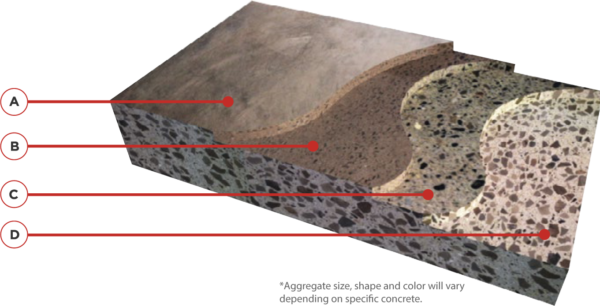Your Floor. Your Options.
First, Choose your Shine

Matte – Level 0, 200-Grit
Matte Finish polishing produces a concrete floor with a soft, matte finish that is easy to maintain. This option is popular in residential and industrial settings, and is the most economical finish level.
Satin – Level 1, 400-Grit
Satin Finish polishing produces a diffused reflection and is a popular base level floor finish.
High Sheen – Level 2, 800-Grit
High Sheen polishing produces a sheen on the floor that will reflect clearly identifiable objects. This is a popular flooring option for restaurants, retail, and other areas where a high sheen is desired.
Super Sheen – Level 3, 1500-Grit
Super Sheen polishing produces a highly-polished surface that reflects color, light, and objects in a mirror-like reflection. This is a popular flooring option for museums, schools, and anywhere a stunning finish is desired.
Second, Choose Your Aggregate Exposure

Class A
Cream Aggregate: Polished surface resulting in little-to-no aggregate exposure. Some light sand exposure.
Class B
Fine/Sand Aggregate: Removes approximately 1/16” of concrete surface by grinding and polishing. This results in the majority of exposure displaying fine sand aggregate with little-to-no medium aggregate in random locations. Light aggregate exposure with some cream.
Class C
Mixture/Medium Aggregate: A deeper aggregate exposure, removes approximately 1/8″ of concrete and consists of a mixture of light to heavy aggregate exposure. This level of exposure is typically expected on remodel work where glues, adhesives, or other floors have been installed in the past.
Class D
Large Aggregate: Removes not more than 1/4” of concrete surface by grinding and polishing. This results in the majority of exposure displaying large aggregate with little-to-no fine aggregate in random locations. Heavy aggregate exposure with some light sand.
Third, Choose Your Color
There are many ways to color a concrete floor. Alternative Edge beleives that the best way to highlight the beauty of concrete is to allow the natural components, cement cream, sand and aggregates to show through. Penetrating dye and reactive stains are the best way to accomplish that.
Penatrating Dye
A penetrating concrete dye can be used on indoor concrete polishing or sealing applications. This dye penetrates deep into the pours of the concrete creating a long-lasting, durable color treatment for interior concrete floors. Depending on the concrete substrate, this translucent coloring system can have variations and marbling. Since it is translucent, like water colors, you will still see the aggregate exposure and other traits of the floor. The penetrating concrete dye is the most economic coloring solution and there are many colors to choose from.
Penatrating Dye Color Options:




Reactive Stains
Using reactive stains, also known as acid stains, to color concrete can result in beautiful mottling, marbling and vibrant colors. Their beauty and brilliance is unmistakable. These stains work with the existing chemical makeup of concrete to produce variegated coloring throughout the surface. Because the mineral make up of every concrete slab is different every acid stained floor is unique. You can expect variations from subtle to astounding.
Reactive Stain Color Options:

Fourth, Choose Additional Options
Grout Coating
The grout coating application fills in naturally occurring pinholes, small air pockets, and aggregate pop-outs in a concrete floor. This process offers a higher overall reflectivity, better stain resistance, a less porous surface, and is recommended for air entrained concrete and/or concrete that will be heavily ground to remove sealers, coatings, or when aesthetics are a top priority. The necessity of this option is typically unknown until the concrete floor has been prepared and the initial grinding pass is complete. Alternative Edge typically includes a grout coat on all residential and commercial floors.
Control Joint Filling
Control Joints are planned by an architect in the design of a space, and placed in the concrete slab right after it is poured. These joints are usually saw-cuts and are filled with a flexible polyurea compound to protect the joint edges from chipping in addition to keeping dirt and debris out. This filler is available in many color options to compliment the floor. Alternative Edge stocks most common colors and can make recommendations to what will look the best.
Concrete Densifying and Stain Guard
All polished concrete floor installations include a two-application process; premium concrete densification treatment and stain guard conditioning. These two steps penetrate into the concrete surface to increase abrasion resistance, decrease permeability, maintain a co-efficient of friction for slip-resistance, and provide one of the most durable hard-surface flooring systems available.
Extra Protection from Oils
If your environment is prone to oil spills or standing water you may consider upgrading with our oil repellant seal. This is a penetrating, empregnating sealer that is applied in addition to our standard stain guard and offers a superb level of protection. This can be added at any time after installation but may dull the sheen slightly.
